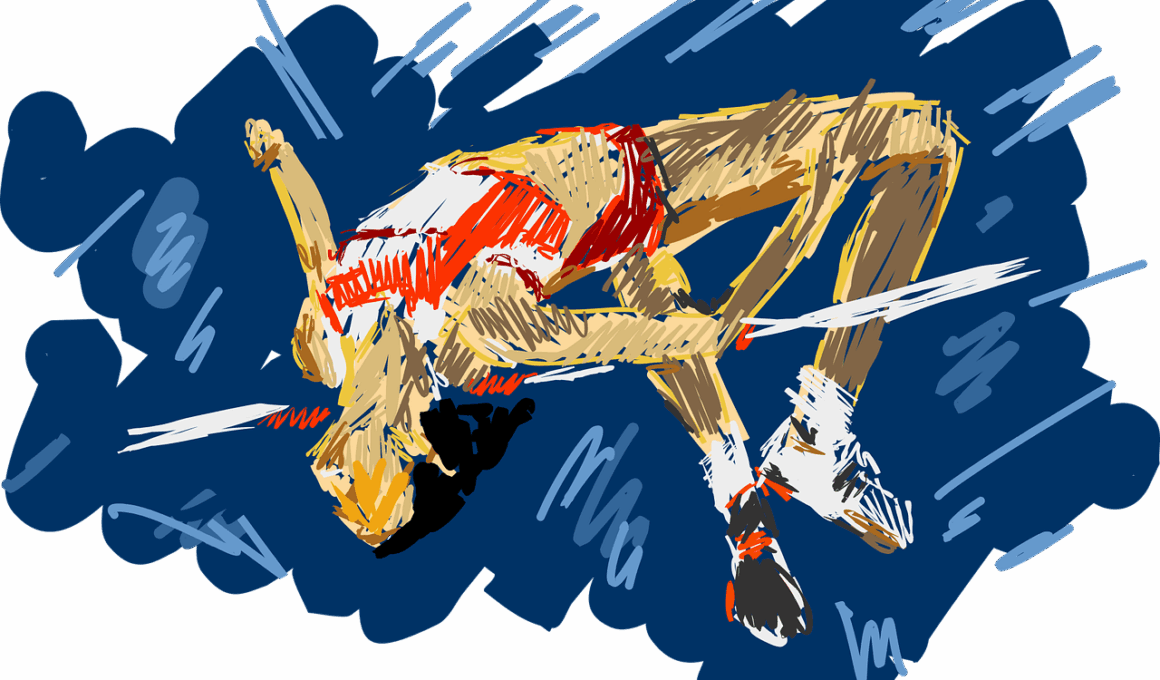The Relationship Between Plyometric Test Scores and Sport Performance
Plyometric testing is crucial in assessing athletic performance, specifically in sports that require explosive strength, agility, and power. These tests typically measure a variety of physical capabilities such as vertical jump, broad jump, and various agility drills. By evaluating these metrics, coaches and trainers can identify areas of strength and weakness in an athlete’s performance. Furthermore, plyometric assessments provide valuable insights into how an athlete might perform under competitive conditions. The link between plyometric test scores and the actual sport performance is evident, as athletes with higher test scores often exhibit superior results in their sporting endeavors. This assessment process not only helps in tailoring training programs but also assists in injury prevention strategies. Athletes can enhance their power and performance capacities over time with consistent plyometric training. This leads to improved results on the field or court. Ultimately, plyometric tests are vital tools for developing effective training interventions and optimizing long-term athletic performance, ensuring that athletes can consistently push their boundaries and achieve new heights in their respective sports.
Understanding the Key Plyometric Tests
Several key plyometric tests are commonly employed to assess an athlete’s explosive capabilities. One standard test is the vertical jump, which measures the height an athlete can jump from a standing position. This test serves as an indicator of lower body power and strength. Another important assessment is the broad jump, which evaluates horizontal explosiveness and leg strength. Agility tests such as the T-test or Illinois agility test measure an athlete’s ability to change directions quickly while maintaining speed. Furthermore, the depth jump assesses reactive strength and the ability to absorb and produce force effectively. These tests, often conducted in controlled environments, provide valuable numerical data that correlate with performance outcomes in various sports. Coaches analyze these results to design sport-specific training regimens. In doing so, they can optimize the plyometric program for individual athletes based on their unique strengths and weaknesses. Regular testing allows for progress tracking and adjustments to training as required, ensuring that athletes achieve their peak performances. In essence, these tests are instrumental in building a comprehensive understanding of an athlete’s plyometric abilities.
One crucial aspect of plyometric testing is the interpretation of scores and their implications for athletic performance. Generally, higher scores on plyometric tests suggest superior power and explosiveness, impacting an athlete’s performance positively in sports. However, it is essential to consider other factors that may influence these results, including body composition, training history, and specific sport requirements. Coaches must recognize that while scores provide insights into potential, they do not solely dictate an athlete’s success. Skills such as technique, strategy, and mental preparedness equally contribute to performance outcomes. An athlete with moderate plyometric test scores may excel in specific sports due to other strengths. Therefore, coaches should integrate plyometric scores with other performance assessments to form a holistic view of an athlete’s capabilities. This comprehensive approach ensures decisions regarding training and athletic development consider all relevant aspects. Tailoring programs to suit individual needs enhances overall performance. Finally, continuous education about the relationship between scores and performance empowers coaches to make informed decisions, leading to better athlete outcomes during competitions.
Variation in Performance Across Sports
The relationship between plyometric test scores and sport performance can vary significantly across different sports disciplines. For instance, in basketball and volleyball, where jumping ability is paramount, vertical jump scores correlate strongly with performance. Athletes who excel in these areas are often better equipped to perform essential skills such as blocking or dunking. Conversely, sports like marathon running may not show the same direct correlation between plyometric scores and success. While lower body strength remains important, other factors like aerobic capacity play a more critical role. Therefore, understanding the specific demands of each sport is crucial when interpreting test scores. Coaches must regard individual sport requirements while designing training protocols. This ensures athletes are not only strong in plyometric tests but also skilled in sport-specific tasks. Integrating plyometric training with other conditioning ensures the best possible athlete preparation. Additionally, recognizing these variances aids coaches in recruiting and developing athletes based on their unique abilities. Thus, the relationship between plyometric scores and sport performance is dynamic and requires a tailored approach across disciplines.
Another important aspect to consider is the impact of training methodologies on plyometric test scores and overall performance. Various training regimes, including traditional strength training, specific plyometric exercises, and sport-specific drills, can significantly influence an athlete’s capabilities. For example, athletes who regularly incorporate plyometric exercises into their training tend to exhibit higher power and explosiveness, resulting in improved test scores. However, improper training methods can lead to fatigue or even injury, leading to diminished performance outcomes. Therefore, it is essential for coaches to understand how to implement plyometric training effectively. Introducing progressive overload and adequate recovery intervals during training sessions ensures sustained performance improvements. Moreover, combining plyometrics with strength training maximizes muscle recruitment. Continuous education about the latest plyometric techniques and safety measures is vital for trainers and athletes alike. This knowledge will contribute to enhancing performance outcomes while minimizing risk. An athlete’s performance is a sum of several variables, including their plyometric test scores, training quality, and innate skills. Comprehensive training methodologies that account for all factors will yield the best results.
Long-term Success and Monitoring
Monitoring plyometric test scores over time provides pivotal insight into an athlete’s development and long-term success. Regular assessments allow coaches to analyze data trends and evaluate the effectiveness of their training regimes. Sustained improvements in test scores often correlate with enhanced sport performance and can guide adjustments to training plans. An athlete who consistently excels in plyometric tests is likely developing the necessary explosive abilities crucial for their sport. Being attentive to patterns in these scores enables coaches to identify whether an athlete responds positively to specific training stimuli or if modifications are necessary. This ongoing assessment creates a feedback loop, allowing athletes and coaches to refine their approach. Furthermore, athletes benefit from understanding their progress, motivating them to pursue continued excellence. The importance of tracking cannot be overlooked; it ensures that all athletes, regardless of skill level, work toward maximizing their plyometric potential. Long-term commitment to improvement in plyometric scores, combined with adherence to sport-specific objectives, will culminate in overall enhanced performance, enabling athletes to achieve their goals and excel in competitive environments.
Ultimately, the relationship between plyometric test scores and sport performance is complex, characterized by various influencing factors. As sports continue to evolve, so does the understanding of how plyometrics contribute to athletic success. Coaches are tasked with staying informed about emerging research and advancements in training methodologies that relate to plyometric performance. Continuous adaptation in training programs is necessary to ensure athletes can reach peak performance levels while minimizing the risk of injury. This thoughtful approach to plyometric training cultivates a culture of excellence among athletes. Each athlete is unique, with different strengths and weaknesses that impact their performance spectrum. Thus, personalizing training based on plyometric scores and sport-specific conditions is vital. Coaches must encourage a balanced approach that embraces diverse planning strategies. Ultimately, the intersection of plyometric training and sport performance offers numerous opportunities for improvement. A commitment to growth in both areas will yield positive outcomes for athletes, advancing their capabilities, skills, and results. As test scores improve, so too will athletic performances grow stronger, paving the way for success in competitions.
Conclusion
In conclusion, the relationship between plyometric test scores and sport performance is a multifaceted topic that warrants attention from coaches, athletes, and trainers alike. Understanding this relationship requires a holistic view that incorporates various factors influencing athletic performance, ensuring well-rounded development. Plyometric assessments are critical tools in this journey, providing quantifiable data that coach can leverage for optimizing training. Continuous monitoring of scores and progress encourages a culture of improvement and adaptability. Moreover, integrating plyometrics into a broader training regimen supports the functional requirements of each sport and the unique characteristics of individual athletes. Emphasis should be placed on understanding the specific outcome targets of different sports, as this knowledge will guide effective training program decisions. As we continue to advance our understanding of performance metrics, our approaches to plyometric training will equally adapt. Ultimately, fostering an environment that prioritizes both physical and mental readiness will empower athletes to excel consistently. By aligning plyometric performance with specific sport goals, athletes can harness their full potential and achieve remarkable feats in their competitions.


